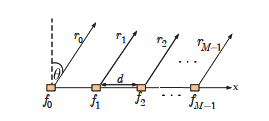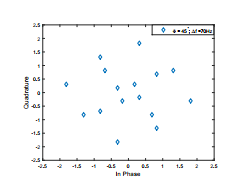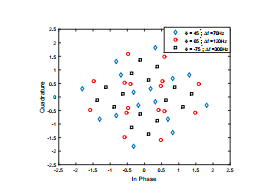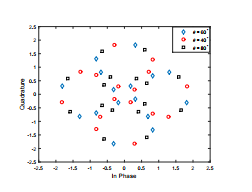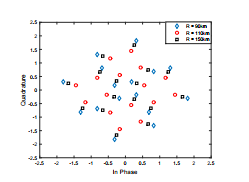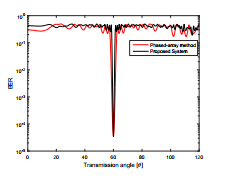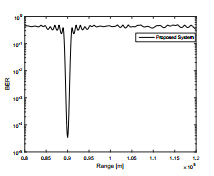Directional Antenna Modulation Technique using A Two-Element Frequency Diverse Array
Directional Antenna Modulation Technique using A Two-Element Frequency Diverse Array
Volume 2, Issue 3, Page No 227-232, 2017
Author’s Name: Shaddrack Yaw Nusenua)
View Affiliations
Koforidua Technical University, Electrical / Electronic Department, Faculty of Engineering, Ghana.
a)Author to whom correspondence should be addressed. E-mail: nusenu2012gh@yahoo.com
Adv. Sci. Technol. Eng. Syst. J. 2(3), 227-232 (2017); ![]() DOI: 10.25046/aj020331
DOI: 10.25046/aj020331
Keywords: Frequency diverse array, Directional modulation, Physical-layer security, Range-angle dependent
Export Citations
Direction dependent antenna modulation (DAM), as a potential physical-layer security technique, is able to enhance the security of wireless communication systems by virtue of the capability of its direction-dependent signal modulation format transmission. In this paper, DAM using frequency diverse array (FDA) to produce the modulation is presented. By phase shifting each element, the desired amplitude and phase of each symbol can be produced during a particular transmission in a given range and angle position determined by the switching speed of the phase shifters. Accordingly, the proposed method offers a robust security for wireless transmission, as the transmitted signal can be purposely distorted in undesired positions, while preserving a clear constellation along prespecified position(s). Numerical examples are given to illustrate the effectiveness of the proposed method.
Received: 04 April 2017, Accepted: 26 April 2017, Published Online: 01 May 2017
1. Introduction
Directional antenna modulation (DAM) transmitter has been recently proposed [1, 2, 3] which has the capability of projecting deliberately distorted signals in all directions in free space other than the pre-specified secure communication directions. In doing so, only intended receivers located along this the secure communication direction are able to capture the signal leading to successful demodulation, while distorted signal emitted along undesired directions make signal demodulation by an eavesdropper a difficult task. Unlike classical cryptographic technique adopted at higher protocol layers to provide encryption, DAM technology does not share any keys, and secures data transmission directly at physical-layer which enables information theoretical security [4].
The basic concept of DAM is that it transmits a signal with a known modulation format to the desired receiver. The transmitted signal can be successfully recovered and demodulated by a receiver with a-prior modulation scheme [3]. For any directions distinct from the desired direction(s), the modulation format imposed on the transmitted signal will change. Thus making it difficult for the eavesdroppers to demodulate. In [2] a similar concept directional modulation (DM) was proposed which employs phased-array antenna. Other researches has proposed different DM transmitters such [5, 6, 7, 8]. Nevertheless, up to now, all published DAM transmitters employs phased-array. Although the DAM techniques using phased-array can steer the beam to an arbitrary direction, but the steering is independent of the range. This is because phased-array produces fixed steering direction at an angle for all the ranges [9].
In fact, the ability to control range dependent transmit energy distribution becomes an important requirement in many applications, for instance, range-dependent interference suppression [10, 11, 12] and directional communications [2]. To address the current needs,frequency diverse array (FDA) provides new opportunities to realize DAM. The FDA concepts was initially introduced in 2006 [13, 14]. They reported that the range-angle-time dependent far-field array pattern formation are the core attributes of the concept. FDA has been defined by [15] as an antenna aperture where the frequency of each antenna element is controlled independently to steer the main beam, depending on the time domain of each frequency component in the farfield. The most significant feature of FDA is that, it employs a small frequency increment across its antenna array elements. This frequency increment makes the array beampattern to change as a function of the range, angle and time [9, 13, 14].
In this contribution FDA elements is configured using DAM technique to achieve physical-layer security in rangeangle dependent. The range and angle dependent DAM is achieved with 2-bit phase controls across the array elements for secure point-to-point communications. The main contributions can be summarized as: 2-bit phase shifters combinations is formulated for the FDA-based DAM to achieve directional range-angle dependent M-ary signal constellations. Compared with conventional phased-array based method, our proposed system achieves narrower demodulation beamwidth for the desired receiver.
In Section II of this paper, FDA DAM for secure pointto-point communications is presented. Numerical results are provided in Section III. Finally, this paper is concluded in Section IV.
2. FDA DAM for Secure Point-ToPoint Communications
The FDA elements can be excited by either the same waveform or different waveforms. Here, the waveform radiated from each array element is assumed to be identical with a frequency offset of ∆f Hz. Consider a uniform linear array (ULA) FDA composed of identical transmit elements with element spacing d. The radiated frequency of a standard FDA from the mth element is given as![]()
where f0 and ∆f are the carrier frequency and frequency offset, respectively, and M is the number of array elements. The transmit beampattern can be represented by (2), [16] with the common phase Φ0 given in (3), where c0 denotes the speed of light and rm ≈ r − mdsinθ, is the target slant range for the mth element and d denotes the element spacing. Equation (2) implies that FDA has range, angle and time dependent transmit beampattern.
To describe directional antenna modulation for Mary transmission, a two-element FDA antenna with 2bit phase control which provides four state units αA = αB = [α1,α2,α3,α4] is configured for each FDA array element as shown in Figure 2. Each FDA element is controlled by the RF switch embedded to specifically select one of four possible phase state units. The four phase state units [α1,α2,α3,α4] herein represents h00,900,1800,2700i phase shifters, respectively. The signals are modulated individually by controlling the element phase shifters with the RF switchers. In doing so, the array radiation pattern will change at each symbol in the digital modulation scheme. A desired constellation pattern can be produced along pre-specified range-angle positions. At the same time, constellation patterns generated for other positions will be distorted.
The array factor for this FDA based DAM transmitter configuration can be expressed as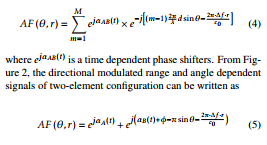
where ejA and ejB, denotes the phase shifters for each
element A and B, respectively. The frequency offset ∆f and phase offset φ are used here as a fixed value in a particular signal transmission. The ∆f and φ can be adjusted when considering different signal transmissions. The phase shifter produce by the φ is assumed to be chosen between −80◦ and 80◦. It is important to note that, the phase shifters provided for FDA elements are based on assumption and their corresponding values are shown in Table I.
It is worth noting that, because the FDA DAM technique depends on switching the antenna elements at each symbol rate, a series of high frequency single-pole multithrow (SPMT) or single-pole-4-throw (SP4T) switches with nanosecond or sub-nanosecond speeds is required [17, 18].
3. Simulation Results and Analysis
3.1 Directional Modulated 16-ary Transmission Analysis
Analogous to [3], sixteen data points was calculated for the desired receiver at the range-angle position (R,θ) = (90 km,60◦). The proposed transmitter system can modulates up to 16-ary unique signal constellation at the far field. When 16-ary transmission is considered, Figure 3 shows the 16-ary unique signal constellation at the intended
receiver position (R,θ) = (90 km,60◦). The modulated signal can be successfully decoded easily by the receiver. Note that in Figure 3, ∆f = 70Hz and φ = 45◦ was adopted. These arbitrary values of both frequency offset ∆f and phase offset φ was chosen to generate 16 unique points at the desired position.
Next, the effect of changing the arbitrary values of both frequency offset ∆f and phase offset φ are examined. As shown in Figure 4, it can be noticed that for distinct values of frequency offset ∆f and phase offset φ, such as ∆f = 70Hz, φ = 45◦; ∆f = 120Hz, φ = 65◦; ∆f = 300Hz, φ =
−75◦; respectively, generate different distributions of constellation points. It is important to note that ∆f and φ may be considered as transmission signatures and can provide a series of different modulation format.
Figure 5 demonstrate how the proposed system provides additional level of security. As shown in Figure 5, the 16 unique data point generated corresponds to ∆f = 70Hz, φ = 45◦ and range R = 90 km for distinct observation angles of θ = 60◦ (desired angle direction), θ = 40◦ and θ = 80◦, respectively. It can be observed that at angles distinct from the desired angle direction, new distributions of modulation format are achieved. This implies that apart from the desired angle direction, all other angle directions received signal constellation changes locations making demodulation by an eavesdropper very difficult.
Similarly, Figure 6 illustrate 16 unique constellations for distinct ranges such as R = 90 km (desired range position), R = 110 km and R = 150 km which corresponds to ∆f = 70Hz, φ = 45◦ and θ = 60◦. It is noticed that at other range positions apart from the desired range position, the signal constellation have different distributions making
it difficult for the eavesdroppers to intercept information. Table 1: Possible phase shifters combinations for FDA DAM using two-element configuration.
| Number | FDA element [αA | αB +φ] | Number | FDA element [αA αB +φ] |
| 1 | h 0 00i 0 | 9 |
h 0 00i 180 |
|
| 2 | h 0 900i 0 | 10 |
h 0 900i 180 |
|
| 3 | h 0 1800i 0 | 11 |
h 0 1800i 180 |
|
| 4 | h 0 2700i 0 | 12 |
h 0 2700i 180 |
|
| 5 |
h 0 00i 90 |
13 |
h 0 00i 270 |
|
| 6 |
h 0 900i 90 |
14 |
h 0 900i 270 |
|
| 7 |
h 0 1800i 90 |
15 |
h 0 1800i 270 |
|
| 8 |
h 0 2700i 90 |
16 |
h 0 2700i 270 |
|
3.2 Bit error rate (BER) Analysis
To demonstrate how the proposed system can be applied to a secure communication system, the simulated bit error rate (BER) of the system is calculated in angle and range dimensions using an algorithm based on minimum distance decoding [2].
The essence of Directional modulation technique is to achieve low BER in a narrow beamwidth toward the intended receiver and still enforce a high BER in other undesired directions. The resulting BERs are shown in Figure 7 and Figure 8 . It is fair to ensure that, all BERs are normalized until they are the same at the desired position. In this fashion, the security in undesired directions can be compared while they have the same performance in the intended direction.
In angle dimension, the proposed system achieves a lower BER in a narrow beamwidth with a relatively constant high BER in other directions than phased-array based method. In range dimension as shown in Figure 8, the phased-array-based method has no range resolution capability. In contrast, the proposed system still has good BER performance in the range dimension due to the frequency offsets ∆f . These results confirm that, the proposed method achieves good security performance in both range and angle dimensions, not just in the angle dimension as the phasedarray-based method and thus yields the worst security performance.
4. Conclusion
This paper has presented a directional antenna modulation scheme using a two-element FDA antenna. The directional manipulation of the constellation points is possible because the signals are modulated at antenna-level with phase shifters changing in each symbol transmission. The proposed system achieves both range and angle dependent DAM for secure 16-ary transmitted symbols for wireless communications. The effectiveness of the proposed system is validated with the aid of constellation diagrams and BER performances. Compared with the phased-array-based DAM method, which scrambles the signal constellations only in undesired angles, the proposed scheme scrambles the signal constellation in both range and angle dimensions. Future work will includes the design of genetic algorithm for phase shifters to improve the security performance.
Conflict of Interest
The author declare no conflict of interest.
Acknowledgment
The author would like to thank Respected Professor Wen-Qin Wang (Senior Member – IEEE) of UESTC for his great contributions, support and encouragement.
- A. Babakhani, D. B. Rutledge, and A. Hajimiri. “Transmitter architectures based on near-field direct antenna modulation,” IEEE Journal of Solid-state Circuits, vol. 43, no. 12, pp. 2674–2692, December 2008.
- M. P. Daly and J. T. Bernhard. “Directional modulation technique for phased arrays,” IEEE Transactions on Antennas and Propagation, vol. 57, no. 9, pp. 2633–2640, September 2009.
- H. Z. Shi. “Physical layer communication using direction antenna modulation,” PhD. dissertation, University Sheffield, London, 2014.
- M. Bloch and J. Barros. “Physical-Layer Security: From Information Theory to Security Engineering.” Cambridge University Press, 2011.
- Y. Ding, Y. Zhang and V. Fusco. “Fourier rotman lens enabled directional modulation transmitter,” International Journal of Antennas and Propagation, vol. 2015, Article ID 285986, pp. 1–13, 2015.
- T. Hong, M.-Z. Song, and Y. Liu. “Dual-beam directional modulation technique for physical-layer secure communication,” IEEE Antennas Wireless Propag. Lett., vol. 10, pp. 1417-1420.
- N. Valliappan, A. Lozano, and R. W. Heath. “Antenna subset modulation for secure millimeter-wave wireless communication,” IEEE Transactions Commun., vol. 61, no. 8, pp. 3231-3245, 2013.
- Nafel N. Alotaibi and Khairi Ashour Hamdi. “Switched Phased-Array Transmission Architecture for Secure Millimeter-Wave Wireless Communication,” IEEE Transactions on Commun., vol. 64, no. 3, pp. 1303–1312, March 2016.
- W.-Q. Wang. “Frequency diverse array antenna: New opportunites,”IEEE Antennas and Propagation Magazine, vol. 57, no. 2, pp. 145-152, April 2015.
- C. Wen, T. Wang, and J.-X. Wu. “Range-dependent clutter suppression approach for non-sidelooking airborne radar based on orthogonal waveforms,”IET Radar, Sonar and Navigation, vol. 9, no. 2, pp. 210- 220, February 2015.
- J. X. Wu, T. Wang, L. F. Zhang, and Z. Bao. “Rangedependent clutter suppression for airborne sidelooking radar using MIMO technique,”IEEE Transactions on Aerospace and Electronic Systems, vol. 48, no. 4, pp. 36473654, October 2012.
- W. S. Yan, X. P. Fang, and J. B. Li. “Formation optimization for AUV localization with range-dependent measurements noise,”IEEE Communications Letters, vol. 18, no. 9, pp. 15791582, September 2014.
- P. Antonik, M. C. Wicks, H. D. Griffiths, and C. J. Baker. “Range dependent beamforming using element level waveform diversity,” in Proceedings of the International Waveform Diversity and Design Conference, Las Vegas, USA, pp. 1-4, January 2006.
- P. Antonik, M. C. Wicks, H. D. Griffiths, and C. J. Baker. “Frequency diverse array radars,” in Proceedings of the IEEE Radar Conference, Verona, NY, April 2006, pp. 215-217.
- Wen-Qin Wang, H. C. So, and Alfonso Farina. “An Overview on Time/Frequency Modulated Array Processing ,” DOI 10.1109/JSTSP.2016.2627182, IEEE Journal of Selected Topics in Signal Processing.
- P. F. Sammartino, C. J. Baker, and H. D. Griffiths. “Frequency diverse MIMO techniques for radar,”IEEE Transactions on Aerospace and Electronic Systems, vol. 49, no. 1, pp. 201222, January 2013.
- M. Madihian, L. Desclos, K. Maruhashi, K. Onda, and M. Kuzuhara. “A high-speed resonance-type FET transceiver switch for millimeterwave band wireless network,” in Proc. Microwave Conference, vol.2, pp. 941 944, 1996.
- J. H. Lee, S. Hong, W. K. Kim, J. W. An, and M. Y. Park. “A switched array antenna module for millimeter-wave wireless communications,” in Proc. Global Symp. Millimeter Waves, pp. 161163, 2008.


